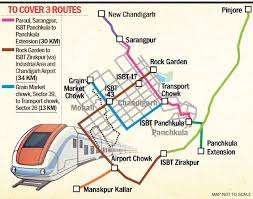Tricity Metro: The draft Alternatives Analysis Report (AAR) emphasizes the environmental impact of the Metro project in Tricity, including anticipated noise and vibration pollution.

The Rail India Technical and Economic Services (RITES) has proposed a two-coach Metro system for the Tricity, which will result in the removal of up to 3,500 trees to build the elevated track corridors.
The Union Ministry of Housing and Urban Affairs (MoHUA) has already approved the construction of Metro lines fully underground in the heritage sectors (1 to 30).
The draft Alternatives Analysis Report (AAR) estimates that 3,500 trees along the project corridors will be removed for the elevated Metro tracks.
Once finalized, the AAR will lead to the preparation of a detailed project proposal for final approval by the ministry.
The report also outlines the environmental impact, noting anticipated noise and vibration pollution from the Metro project. The noise level is expected to reach 66.4 decibels, based on two-coach systems and a design speed of 90 km/h.
Additionally, the report specifies that the maximum sectional speed of the Metro will be 95 km/h, subject to adjustments based on horizontal curve radius, cant, and cant deficiency. The Metro system is projected to handle between 15,000 and 100,000 passengers, meeting peak-hour demand well into 2056.
In 2023, the Chandigarh Administration prepared the Comprehensive Mobility Plan (CMP) for the Tricity, targeting the year 2052. The plan advocates for an integrated multi-modal mass transport system, incorporating various transport modes, including Metro Rail Transit Systems (MRTS) and dedicated bus corridors, to address traffic needs through 2052.
Current Traffic Characteristics:
The report highlights that approximately 80% of trips are made by vehicle, while 20% are on foot. Two-wheelers account for about 34% of trips, with buses serving as the major public transport mode, covering 5.3% of total trips. Car trips make up 9.3%. There are roughly 2.63 million motorized internal trips across different modes. The per capita trip rates are 1.5 including walking trips, 1.2 excluding walking trips, and 1.07 for motorized trips. About 50% of vehicular trips and 10% of walking trips are for work or business. For educational purposes, 35.5% of trips are by vehicle and 38% are on foot. When it comes to shopping and recreation, around 11% of trips are by vehicle and 41% are on foot.
